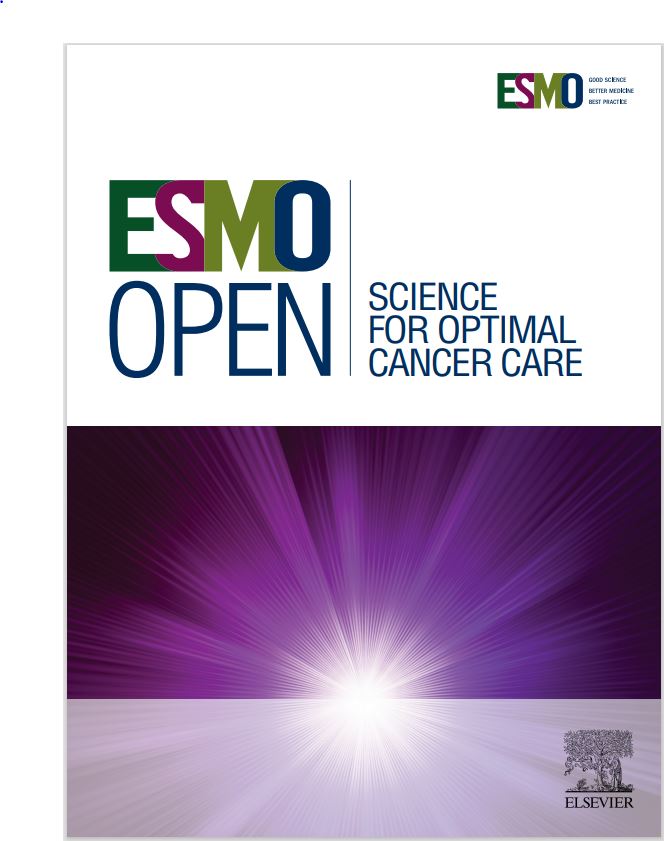131 - mibg治疗复发/难治性神经母细胞瘤:通往未来的旧桥
IF 7.1
2区 医学
Q1 ONCOLOGY
引用次数: 0
摘要
复发/难治性(R/R)神经母细胞瘤(NB)的预后仍然令人沮丧。碘-131间碘苄基胍(131I-mIBG)治疗作为新型免疫治疗前减轻肿瘤负担的工具的作用尚未明确。患者和方法R/R NB患者被纳入一项前瞻性观察研究,该研究基于两次输注131I-mIBG + melphalan (110 mg/m2),并辅以自体造血干细胞救援。第一次给药的活度为444 MBq (12 mCi/kg),而第二次给药的剂量经过调整,达到4 Gy的全身吸收剂量。反应采用国际神经母细胞瘤反应标准(INRC)。结果26例患者接受治疗,中位年龄5.9岁(2.5 ~ 17.2岁)。23例患者表现为骨/骨髓受累,21例患者表现为原发部位或软组织部位摄取。国际儿科肿瘤学会欧洲神经母细胞瘤组(SIOPEN)骨骼评分中位数为10(范围1-70)。记录的主要毒性为血液学毒性,无中毒性死亡,仅有1例4级粘膜炎。14例存活患者中有6例甲状腺功能减退。总有效率为48%[95%可信区间(CI) 28%至69%],只有一次进展;治疗后SIOPEN骨骼评分中位数为6(范围0-70),中位数降低35%(范围4.3%-100%)。总体而言,52% (95% CI 32%至73%)的患者达到/维持了SIOPEN骨骼评分<;7, 67% (95% CI 43%至91%)的患者出现了5厘米的软组织病变。在此治疗后,65%的患者接受了靶向gd2的嵌合抗原受体(CAR)- t细胞治疗,50%的患者接受了布苏凡和美伐兰的大剂量化疗。3年总生存率为55% (95% CI 33% ~ 73%),无事件生存率为42% (95% CI 23% ~ 60%)。结论131I-mIBG联合melphalan治疗可有效减轻/控制肿瘤负担。需要进一步的研究来阐明这种治疗的作用和时机,并将其在CAR-T细胞策略中的作用整合起来。本文章由计算机程序翻译,如有差异,请以英文原文为准。
131I-mIBG therapy in relapsed/refractory neuroblastoma: an old bridge to the future
Background
The prognosis of relapsed/refractory (R/R) neuroblastoma (NB) is still dismal. The role of iodine-131 meta-iodobenzylguanidine (131I-mIBG) treatment as a tool to reduce tumour burden before novel immunotherapies is not defined.
Patients and methods
Patients with R/R NB were included in a prospective observational study based on two infusions of 131I-mIBG plus melphalan (110 mg/m2), supported by autologous haematopoietic stem cell rescue. The activity of the first administration was 444 MBq (12 mCi/kg), while the second dose was modulated to reach a whole-body absorbed dose of 4 Gy. The International Neuroblastoma Response Criteria (INRC) were used for response.
Results
Twenty-six patients with a median age of 5.9 years (range 2.5-17.2 years) were treated. Twenty-three patients presented a bone/bone marrow involvement, and 21 patients presented an uptake at primary site or at soft-tissue sites. The median International Society of Paediatric Oncology Europe Neuroblastoma Group (SIOPEN) skeletal score was 10 (range 1-70). The main recorded toxicities were haematological, with no toxic deaths and only one grade 4 mucositis. Hypothyroidism was reported in 6 patients of the 14 alive patients. The overall response rate was 48% [95% confidence interval (CI) 28% to 69%] with only one progression; after treatment the median SIOPEN skeletal score was 6 (range 0-70) with a median reduction of 35% (range 4.3%-100%). Overall, 52% (95% CI 32% to 73%) of patients achieved/maintained a SIOPEN skeletal score <7 and a soft-tissue lesion <5 cm was seen in 67% (95% CI 43% to 91%). After this treatment, 65% of patients underwent GD2-targeting chimeric antigen receptor (CAR)-T-cell therapy and 50%, high-dose chemotherapy with busulfan and melphalan. The 3-year overall survival was 55% (95% CI 33% to 73%) and event-free survival was 42% (95% CI 23% to 60%).
Conclusion
The 131I-mIBG therapy plus melphalan is confirmed to be effective to reduce/control tumour burden. Further studies are needed to clarify the role and timing of this treatment and to integrate its role in the strategy of CAR-T cells.
求助全文
通过发布文献求助,成功后即可免费获取论文全文。
去求助
来源期刊

ESMO Open
Medicine-Oncology
CiteScore
11.70
自引率
2.70%
发文量
255
审稿时长
10 weeks
期刊介绍:
ESMO Open is the online-only, open access journal of the European Society for Medical Oncology (ESMO). It is a peer-reviewed publication dedicated to sharing high-quality medical research and educational materials from various fields of oncology. The journal specifically focuses on showcasing innovative clinical and translational cancer research.
ESMO Open aims to publish a wide range of research articles covering all aspects of oncology, including experimental studies, translational research, diagnostic advancements, and therapeutic approaches. The content of the journal includes original research articles, insightful reviews, thought-provoking editorials, and correspondence. Moreover, the journal warmly welcomes the submission of phase I trials and meta-analyses. It also showcases reviews from significant ESMO conferences and meetings, as well as publishes important position statements on behalf of ESMO.
Overall, ESMO Open offers a platform for scientists, clinicians, and researchers in the field of oncology to share their valuable insights and contribute to advancing the understanding and treatment of cancer. The journal serves as a source of up-to-date information and fosters collaboration within the oncology community.
 求助内容:
求助内容: 应助结果提醒方式:
应助结果提醒方式:


